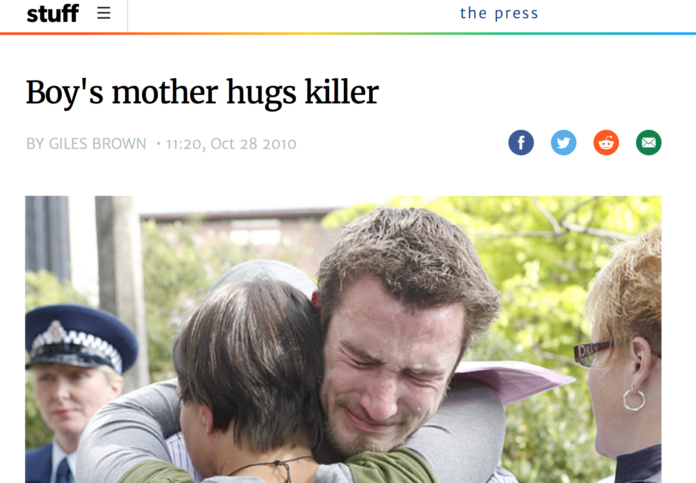It is over a year since the August 2018 hui told the government that imprisonment was not working to solve the problem of crime in Aotearoa. The model of high security prisons, guards running around in stab-proof vests, top-down security, very limited access to programmes to solve the mental health and addictions that are rife in our prisons and so on, known as the American model, just makes things worse, is extremely expensive and a blight on our society.
There are some figures that I like to cite. New Zealand is No. 2 on the Index of World Peace (this is despite our high imprisonment rate, which is an indicator in this index). We are number 8 on the World Happiness index (yes there is such a thing, and yes we are). One of the world’s most peaceful and happy lands.
Out of 223 countries listed, where do you think we rank (from lowest to highest) on the world imprisonment rate? About halfway, perhaps? Halfway is the United Kingdom (rank 112), with a rate of 140 for every 100,000 persons. Higher than most countries in Europe (which, as of today, the UK officially still is), there are major policy efforts over there to bring this figure down.
Perhaps we are closer to the Australian figure? Where will we find them on the index? Oh yes, they rank 132, worse than the UK but… nowhere near the NZ ranking. While we always exceed Australia on measured outcomes such as peace and happiness (for good reason), they beat us hands down for keeping people out of prison.
So there we languish, sitting uneasily between Moldova and Honduras, in 163rd place, around 75% down the table of imprisonment from least to most imprisoned. We have not always been in that uncomfortable space. Even as late as the 1980s, there were around 2,000 people in prison, comparable perhaps to around 3,000 to 4,000 now, with our increased overall population.
Then came the neo-liberal 1990s, the professionalisation of state incarceration, the wrapping of all our prisons in the wire and barbs of high security, a small amount of privatization (the Serco prison at Wiri, which is by no means the most authoritarian of our prisons), and the growth of a new, but implicit view that incarceration should be common and punitive. The views of the Sensible Sentencing Trust came to rule the airwaves, with the mantra of lock ‘em up.
I remember the occasion when I realised that that this culture was far from endemic – that alternatives were possible. You may remember it too. Emma Woods was walking with her two sons along Linwood Avenue in Christchurch when a young man (then aged 17) lost control of his car, barrelling into the family and killing one of the boys.
The parents made it clear from the start that they wanted none of the punitive nonsense that was so strong at the time around the country. In particular, they said that they did not want the driver to go to jail. They saw nothing to be gained in such a punishment. And the court respected that view, dishing out community service and a fine.
What was interesting was the consternation with which the parents’ grace was met by the national media. It is not that the parents did not mourn for their son – their victim impact reports were a searing reminder of what it is to lose a child – but they were steadfastly against imprisonment as a solution, recognising that it did not solve anything. This young man has never since offended, as far as I can see from media reports. Had he gone to prison, who knows how he may have turned out?
So how do we do it? First, I think we need to raise the threshold for who goes to prison, changing consideration of sentencing. The judge issuing the sentence would need to show either that the person needs to be incarcerated to keep others safe, or the crime is so serious that the community demands a severe punishment, and that the prison environment is required to provide a therapeutic and educative environment for anyone sentenced to it (an imprisonment plan, if you like).
Anyone who is in prison who is either low or minimum security (which is over half of the prison population) should not be there unless there is a real and present threat to persons outside from ‘his’ release (this group is nearly all men who threaten women). Anyone in for non-violent offences should be considered for therapeutic options outside the prison.
Don’t even get me started (again) on our dreadful record of holding people for months or more in prison without trial or access to rehabilitative services. Our remand record is dreadful, with (for example) 40% of women prisoners currently being held on remand. Reduce! Reduce! Change the law back to how it use to be!
How about this one: under virtually no circumstances would a mother actively caring for her children attract incarceration as a sentence (I didn’t make it up, there is some recent research on this). My avid readers will know that I am very interested in non-authoritarian forms of incarceration for women which are cheaper and much more effective in reducing recidivism.
Prison is too often in sentencing rules a first rather than a last resort. We need to turn that around. And quickly, please – time is running out for justice reform.
Dr Liz Gordon is a researcher and a barrister, with interests in destroying neo-liberalism in all its forms and moving towards a socially just society. She usually blogs on justice, social welfare and education topics.






AS a matter of fact the USA model is working. The USA has seen multi-decade long reduction in its crime rate.
Same here – long term trends in violent crime show a steady drop.
Could you please provide evidence of your claim of “multi-decade long reduction” David? It appears that last years rate was less than 2009 when a record that had been built up over many decades. Since then, there have not successive reductions. There was a significant drop during the period of the Vietnam War – any parallels? Clearly, the recent reduction is not multi-decade long.
see here:
USA: https://qph.fs.quoracdn.net/main-qimg-4be4efb07103b0af5e6b50d7062adbbd
NZ: https://www.kiwiblog.co.nz/wp-content/uploads/2014/04/crime.png
It is unclear as to what the graph from Kiwiblog is meant to convey as there is no legend, explanation or background information.
That aside, the confounding issue is that the relationship between reported crime rates and imprisonment rates are distorted by a significant number of variables, so it is not valid to base an argument on interdependence. Also, is one to assume that reported crime is much higher is jurisdictions that have very low imprisonment rates based on your original ‘fact’? Obviously, your point does not counter Dr. Gordon’s assertions that are based on sound research
Imprisoning people only achieves one thing.
A cheap frisson up a person whom you would not want to be marooned on a desert island with.
It starts at school when kids surround others in ‘disagreement’ chanting ” Fight! Fight! Fight!”.
They often grow into narcissistic sociopaths who get the aforementioned frisson out of seeing misery and violence. And all the more fun if one gets to inflict that misery. What a vile way to vent one’s cruel streaks and get clean away with it?
Prisons are sadistic and damaging and don’t listen to the idiot above wearing an Andrew skin. He knows what he’s talking about and what he’s talking about is bullshit so why, andrew?
You think that knowing there are those who live in small boxes for years and years is the thing to curb crime?
That, in itself, should be a crime. I hope to God you’re not a Magistrate.
Although I agree that it is wrong and likely counterproductive to lock people up for any reason but to keep the rest of society safe, the statistics quoted contradict the argument attributed to them here. If a high ranking in peacefulness coincides with a high ranking in incarceration as shown the evidence in that is that the high imprisonment rate benefits the peacefulness of the society.
Certainly though it is clear that Rogernomics that threw a slice of our working population onto the scrap heap was what caused the problem.
D J S
Thanks Liz. STOP STOP STOP locking up people. Get the rivers cleaned. Make people feel they are doing something for society. Learning to be a crim in prison is so nuts. Recruitments to the gang happens in prison. What happened to the trip that that bloke from the sensible sentencing trust went to with officials from our prison service, he went to one of the Nordic prisons then to the horrific Texas? prison where people were living in tents and he personally opted for the Texan model. What actually was the point of all of this given we don’t seem to have learnt anything from the experience. All prisons get drug & alcohol counselling, they learn a trade…..
“Prisons in Sweden, Norway and Finland have a smaller average inmate population, bigger cells and broader access to social services than jails in English-speaking countries, a 10-year study has found”.
“In the Nordic countries, the punishment is deprivation of liberty and you don’t need to impose extra punishment. That was not the case with the Anglophone countries,” said Dr Anna Eriksson, Senior Lecturer in Criminology at Monash University, who co-authored the book with Professor John Pratt from the Victoria School of Wellington.
https://theconversation.com/nordic-prisons-less-crowded-less-punitive-better-staffed-12885
One of the biggest problems is that we live in a punitive society if you do something wrong you must be PUNISHED PUNISHED PUNISHED. No compassion no recognition of the appalling background – not of their own making – of the many in prison, no real help with mental health and addiction issues.
I think there are some great programmes but they are too small, some prisoners in Otautahi learning how to farm, things like this where there might be jobs available when you are released.
Help with integrating back into the family on release, learning te reo, learning your whakapapa, having a real job, having support around you, ongoing counselling if needed.
Perhaps 150 – 200 people need to be in prison for the good of themselves and society, rapists, murderers, paedophiles. Don’t these people anyway have serious mental health problems if they believe these things are okay/normal to do.
Take a look at the Singapore system.
I know a kid that received six lashes and 6 months inside for property damage (His parents divorced and he basically ran loose). The difference is that he received daily counselling by a psychologist, work training and army style discipline.
The outcome was amazing! He went in an unruly little shit and came out a self disciplined man. So it can be done but it needs effort and money.
Comments are closed.